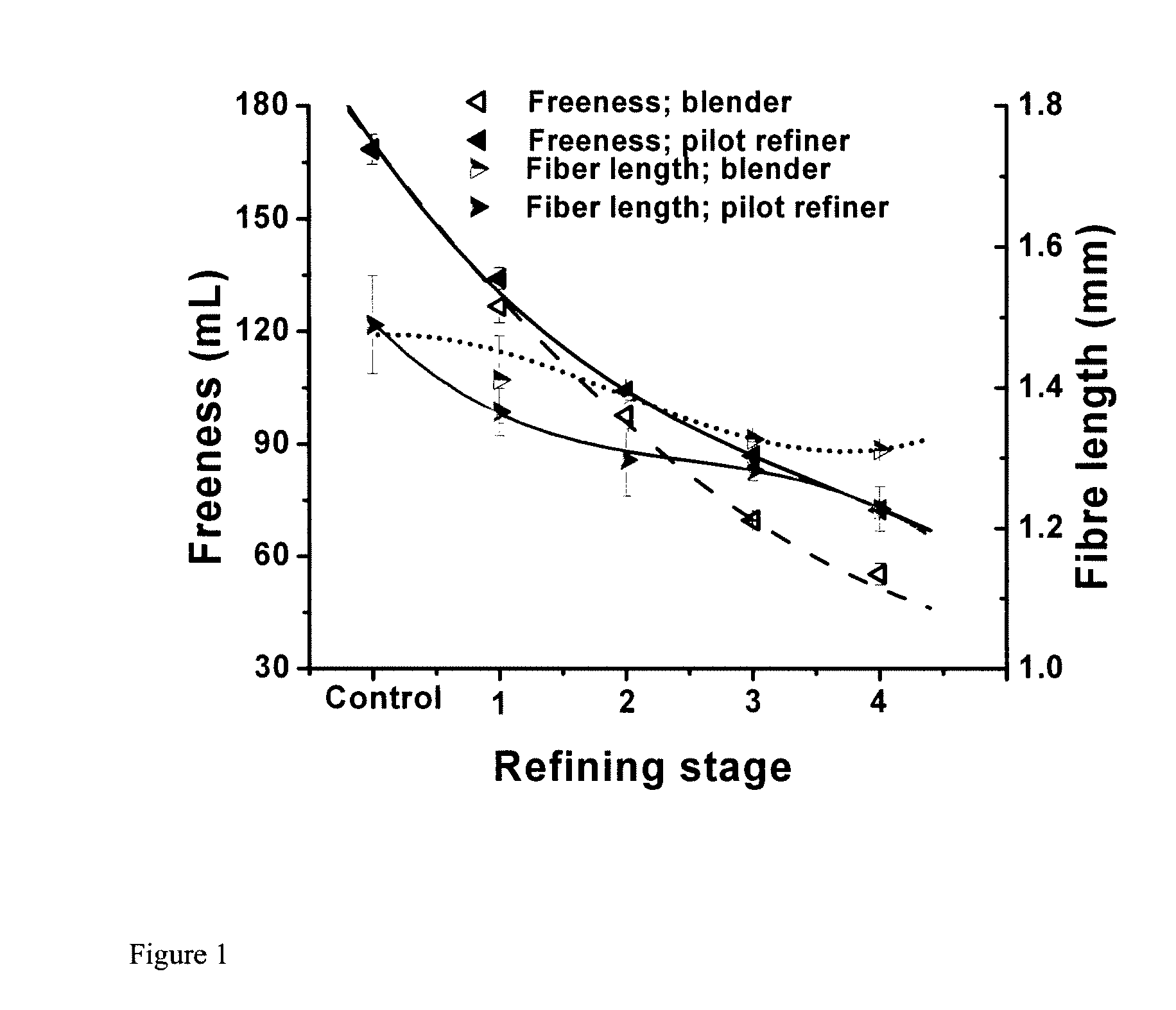Process for reducing specific energy demand during refining of thermomechanical and chemi-thermomechanical pulp
a technology of thermomechanical and chemithermomechanical pulp, which is applied in the field of thermomechanical or chemithermomechanical pulp specific energy demand reduction, can solve the problems of large amount of energy that is not applied directly to refining pulp, and the mechanical refining of pulp at a high consistency requires a large amount of energy, so as to achieve low consistency and electrical energy savings. , the effect of reducing the specific energy required to achieve the desired pulp quality
- Summary
- Abstract
- Description
- Claims
- Application Information
AI Technical Summary
Benefits of technology
Problems solved by technology
Method used
Image
Examples
example 1
Materials
[0114]The pulp used for the validation of the laboratory simulation of LC refining was a thermomechanical pulp (TMP) prepared from whole log hemlock wood chips in the Andritz pilot plant, Springfield, Ohio. The pulp used for alkaline peroxide treatments was a second-stage outlet TMP made from a mixture of pine, hemlock, and spruce chips in the Elk Falls mill of Catalyst Papers. The freeness values of the pulps used for simulation and alkaline peroxide treatments were 168 ml CSF and 137 ml CSF respectively.
Refining
[0115]Pilot plant LC refining was conducted using a 22″ Andritz TwinFlow pilot refiner at 4% consistency with 90 kWh / t of specific energy per pass from tank to tank at Andritz pilot plant.
[0116]Refining with the “Waring Blendor” used a blender with a 1 L capacity bowl. A 500 mL suspension of pulp at 2.4% consistency was blended in the blender for 10, 20, 30 or 40 minutes at 115 V and 1.9 A.
[0117]Refining with a PFI mill followed the PAPTAC method C.7 except in that...
example 2
[0126]Validation of the LC Refining Simulation with a Blender
[0127]In order to efficiently evaluate the effects of various alkaline peroxide treatments on TMP before and after LC refining in the laboratory, it was necessary to find a suitable laboratory scale device that could mimic LC refining. Previously, Shaw [7] found that a blender with a one gallon container could mimic the second-stage HC refiner in thermomechanical pulping. More recently, French and Maddern [8] were able to mimic a high shear low load refiner using a “Waring Blendor” with a one litre container. Based on these previous studies, the possibility was explored of using the “Waring Blendor” to mimic a low consistency refiner. It was determined that when 500 mL of pulp at 2.4% consistency was refined for 10 minutes in a 1 litre “Waring Blendor” the freeness drop and tensile gain were similar to those obtained when the same pulp was refined in the LC refiner in the mill at a specific energy of 100 kWh / t. To further ...
example 3
Effects of Alkali Peroxide Treatment on TMP Properties and Response to LC Refining
[0131]Based on the above findings, the “Waring Blendor” was used to examine the effects of alkaline peroxide treatments on the response of TMP to subsequent LC refining. A second-stage TMP, HC refined to 137 mL freeness, was treated with different combinations of sodium hydroxide and hydrogen peroxide (Table 1) before being blended for 10 min. As discussed in Example 2, the blending corresponds to the application of 110 to 150 kWh / t specific energy at a pilot scale. The properties of the alkaline peroxide treated pulps were tested before and after blending. Yield losses were a maximum of 4% at the higher alkali charges [9].
Handsheet Properties
Tensile Strength
[0132]FIG. 2 shows that both alkali and hydrogen peroxide increased the tensile strength of the TMP prior to LC refining. For a given peroxide charge, tensile strength increased significantly with increasing initial pH above pH 12, which is similar...
PUM
 Login to View More
Login to View More Abstract
Description
Claims
Application Information
 Login to View More
Login to View More - R&D
- Intellectual Property
- Life Sciences
- Materials
- Tech Scout
- Unparalleled Data Quality
- Higher Quality Content
- 60% Fewer Hallucinations
Browse by: Latest US Patents, China's latest patents, Technical Efficacy Thesaurus, Application Domain, Technology Topic, Popular Technical Reports.
© 2025 PatSnap. All rights reserved.Legal|Privacy policy|Modern Slavery Act Transparency Statement|Sitemap|About US| Contact US: help@patsnap.com



